Bean Hollow & Pebble Beach, May 11, 2014
By Toni Corelli, Chapter Chair Rare Plants, San Mateo County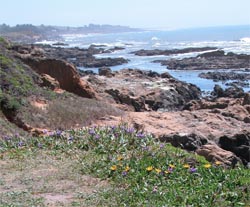
The one mile walk along the Arroyo de los Frijoles (Creek of the Beans) Trail between Pebble Beach and Bean Hollow Beach offers a close-up look at tide pools, wildflowers and colonies of harbor seals and shorebirds.
Read more (PDF) ...
Cascade Field, Part of Año Nuevo State Park, May 2014
By Toni Corelli, Chapter Chair Rare Plants, San Mateo County
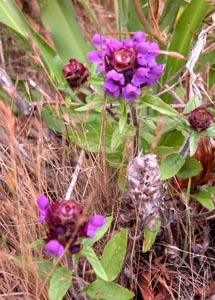
Cascade field is the best example of native coastal terrace prairie and associated wildflowers along the San Mateo Coast. Eight people joined California Native Plant Society member Toni Corelli (This email address is being protected from spambots. You need JavaScript enabled to view it.) and State Park volunteer Avis Boutell on the May 6, 2014 walk along the Atkinson Bluff Trail at Cascade Field.
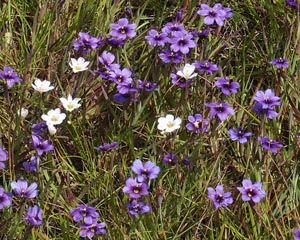
In the past the prairie was managed through fire by the Native Americans to bring grazing animals into the area and enhance desired plants that produce seeds that were gathered for food. Coastal prairies require some sort of disturbance regime to sustain them--either by grazing or fire--or bushes will grow and the prairie will turn into coastal scrubland.
Read more ...
Sharsmith Herbarium 2013
By Carol Mattsson, Chapter Newsletter Editor
On September 15, 2013 I joined several other Chapter members in a field trip to visit Sharsmith Herbarium at San Jose State University. The trip was led by Curator Toni Corelli and Assistant Curators Teri Barry and Lars Rosengreen.
The herbarium is named for botanist Carl Sharsmith, who started the herbarium and collected and mounted over 15,000 specimens. We started our tour in the room with the many rows of cabinets holding the herbarium sheets.
SPECIMEN SHEETS
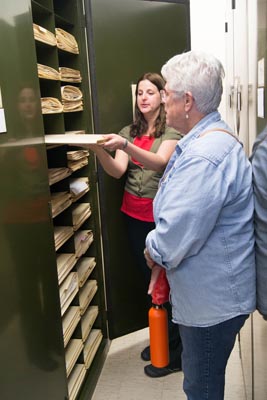 The curators had taken out several specimen sheets for us to examine
The curators had taken out several specimen sheets for us to examine 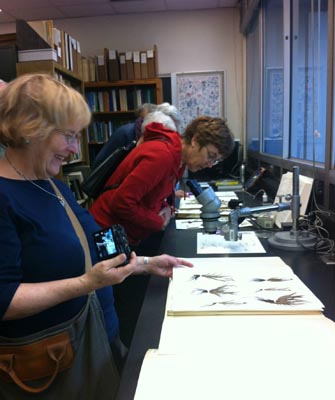 . We learned that the most damage to the specimens is from insects. Thus the first step for a dried, pressed plant specimen to become part of the herbarium collection is to freeze it for a week at -20 degrees F. When we examine the specimen we are to keep the sheet specimen-side up, and not roll or bend it in any way. After we examine the specimen we put the sheet in a special case designated for a refreeze before being restored to its permanent cabinet.
. We learned that the most damage to the specimens is from insects. Thus the first step for a dried, pressed plant specimen to become part of the herbarium collection is to freeze it for a week at -20 degrees F. When we examine the specimen we are to keep the sheet specimen-side up, and not roll or bend it in any way. After we examine the specimen we put the sheet in a special case designated for a refreeze before being restored to its permanent cabinet.
I like ferns so I enjoyed a good look at a specimen of Dryopteris arguta. 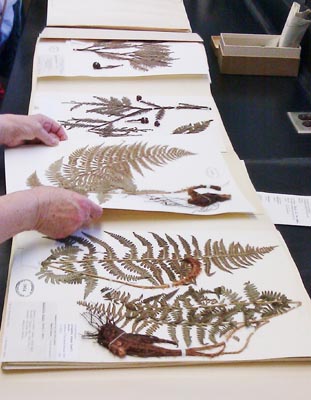 This specimen had the roots tied to the page with special linen thread, and in other places the specimen was attached to the page with special linen strips. As you can see in the photo, each herbarium sheet has a unique identifying number, called the "accession number." The sheets contain labels identifying the specimen: The lower right is the original label, showing plant name, date collected and by whom, location found, and other information. A second newer, smaller label is being added to all the specimens now, giving the plant's name in the 1993 version of the Jepson Manual.
This specimen had the roots tied to the page with special linen thread, and in other places the specimen was attached to the page with special linen strips. As you can see in the photo, each herbarium sheet has a unique identifying number, called the "accession number." The sheets contain labels identifying the specimen: The lower right is the original label, showing plant name, date collected and by whom, location found, and other information. A second newer, smaller label is being added to all the specimens now, giving the plant's name in the 1993 version of the Jepson Manual.
Read more ...
Keying With Natives
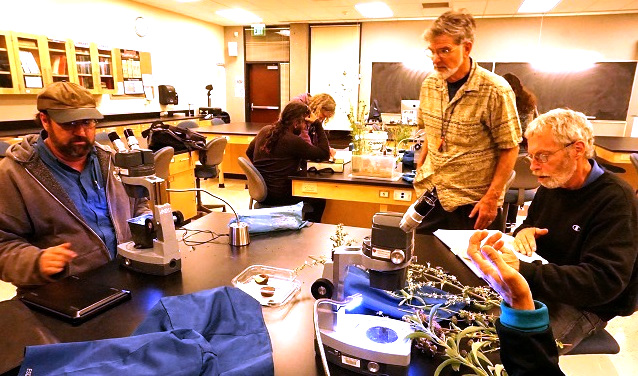
Keying With Natives is a Chapter group that promotes plant identification training using botanical keys. Join us as we learn and practice methods of identifying the native plants of our region. From beginners to more advanced, there are challenges for all. Bring in plant samples if you have some or just come and work with the materials provided. We primarily use Jepson Manual, 2nd edition, so please bring yours if you have a copy. Other plant books are welcome as well, and we often practice keying with them. Botanical microscopes are available.
Keying With Natives Lectures
Two online classes go over the basics of Plant Morphology and the basics of Plant Taxonomy. They cover the basic principles of morphology, which is the study of the form, external structure and development of plants; and the basic principles of taxonomy, which is to learn and look at different plant families. The classes form a great crash course for beginners who are enthusiastic about learning how and why some plants are named ̶ and for others they’ll form a refresher. By knowing the basic morphological characteristics of plants, a plant’s name will become obvious. Once the plant has been identified, it can be placed within categories, a plant family, a classification system that is part of plant taxonomy.
Dee recommends these resources for this class: Plant Identification Terminology, An Illustrated Glossary, by James G. Harris and Melinda Woolf Harris, 2nd Edition; https://vplants.org/portal/plants/glossary/index.php; cuttings of your favorite native plants from your garden as samples; and a hand lens.
Dee Himes is a CNPS SCV board member, Field Trip Chair, and former chapter Treasurer (2012-2014) and Field Chair (2014-2018). She is also an active “Weed Warrior” at Edgewood County Park and Preserve. She is now an Adjunct Instructor of horticulture at Foothill College, in their Environmental Horticulture and Design program, which she also graduated from with an A.S. in 2006. Dee is passionate about sharing her landscape and horticultural experiences and expertise in caring for California native gardens that includes sustainable gardening practices.
When health regulations allow, Keying With Natives meets the last Friday of the month at the Peninsula Conservation Center, 3921 E Bayshore Rd, Palo Alto. Join other native plant enthusiasts in a fun and educational atmosphere, as we hone our skills at plant identification (aka “keying”). For details, contact Joe Cernac atThis email address is being protected from spambots. You need JavaScript enabled to view it..

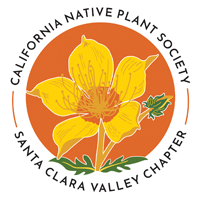



 The curators had taken out several specimen sheets for us to examine
The curators had taken out several specimen sheets for us to examine  . We learned that the most damage to the specimens is from insects. Thus the first step for a dried, pressed plant specimen to become part of the herbarium collection is to freeze it for a week at -20 degrees F. When we examine the specimen we are to keep the sheet specimen-side up, and not roll or bend it in any way. After we examine the specimen we put the sheet in a special case designated for a refreeze before being restored to its permanent cabinet.
. We learned that the most damage to the specimens is from insects. Thus the first step for a dried, pressed plant specimen to become part of the herbarium collection is to freeze it for a week at -20 degrees F. When we examine the specimen we are to keep the sheet specimen-side up, and not roll or bend it in any way. After we examine the specimen we put the sheet in a special case designated for a refreeze before being restored to its permanent cabinet. This specimen had the roots tied to the page with special linen thread, and in other places the specimen was attached to the page with special linen strips. As you can see in the photo, each herbarium sheet has a unique identifying number, called the "accession number." The sheets contain labels identifying the specimen: The lower right is the original label, showing plant name, date collected and by whom, location found, and other information. A second newer, smaller label is being added to all the specimens now, giving the plant's name in the 1993 version of the Jepson Manual.
This specimen had the roots tied to the page with special linen thread, and in other places the specimen was attached to the page with special linen strips. As you can see in the photo, each herbarium sheet has a unique identifying number, called the "accession number." The sheets contain labels identifying the specimen: The lower right is the original label, showing plant name, date collected and by whom, location found, and other information. A second newer, smaller label is being added to all the specimens now, giving the plant's name in the 1993 version of the Jepson Manual.